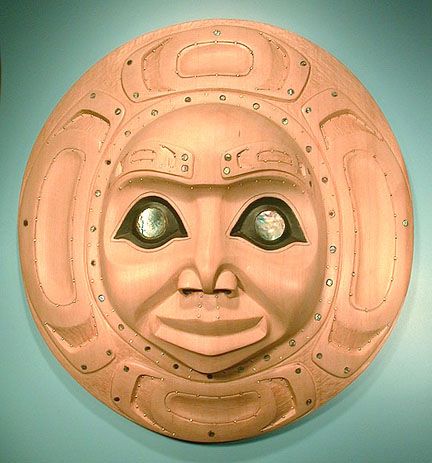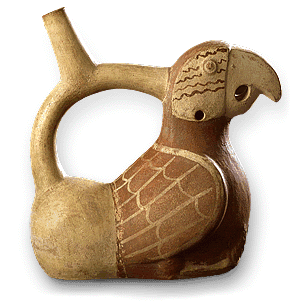
Module 1A: Defining Anthropology
 |
Iroquois Mask by Michelle Foley |
MODULE 1: WHAT IS ANTHROPOLOGY?
Module Outline:
| Moche Whistle Pot, Peru |  |
A. LECTURE 1: Defining the Field of Anthropology:
ANTHROPOLOGY is the study of human kind, including the cultural and biological aspects of being human, and the study of human groups, both past and present. It also includes the study of our closest relatives, the primates, in order to better understand ourselves. Lets break that definition up at bit. What do we mean by 'being human'? When you look out into the world of animals, when you are walking down the street, what tells you that the person walking toward you is a human and not a wombat?
When students answer this question, one of the first things that comes to mind is that we walk on two legs. This ability to walk on two legs is referred to as BIPEDALISM. But does this distinguish us from other critters? Are there other animals that walk on two legs? Birds walk on two legs, but this is not their primary mode of locomotion. Chimpanzees often walk on two legs, but again their bodies are primarily designed to walk as quadrupeds and to climb trees.
The possession of a large brain is considered another hallmark of being human, and indeed relative to our body size, we have very large brains. The absolute size of the brains of elephants and whales are larger than ours, but our brain is larger relative to our body size (Mathematically: Brain Size divided by Body Size). The evolution of a large brain in humans is referred to as ENCEPHALIZATION.
Bipedalism and encephalization are biological aspects of being human. Other biological aspects that distinguish us from most other animals include hairlessness, a specialized voice box, dexterous hands with opposable thumbs, etc. These biological aspects have enabled us to develop cultural aspects that distinguish us from other animals. These include tool use, art, music, mathematics, religion, language, abstract thought, non-present thought (being able to think and talk about events in the past or future), and learned behavior.
Do all of these distinguish us from all other animals? Not entirely. For decades tool use was considered the hallmark of humans; a characteristic that no other animal possessed. Although other animals use sticks and rocks to build homes and forage for food, these are not considered true tools because they are not modified. A TOOL must be modified for a specific use to be considered a true tool.
Jane Goodall surprised the world when she documented the use of true tools by chimpanzees. Many of you have heard of chimpanzees using blades of grass to extract termites from a termite mound. She observed the chimps first trimming the blades of grass to the appropriate diameter before sliding the grass into the termite mound. She sat with them and imitated their behavior so that the chimps would be more comfortable in her presence. I believe she only pretended to eat the termites, but she went through the process of trimming the grass blades. However, she unwittingly was peeling them in a slightly different manner that the chimps were. The next time she went back to study the chimps, they had adopted the new method and had spread the practice to a neighboring group of chimps!! In cultural anthropology we refer to this type of spread of information as CULTURAL DIFFUSIONISM. This transfer of cultural information was previously thought to happen among humans only. Incidentally, chimps have also been taught by humans to make simple stone choppers.
Language is another cultural trait that can not completely distinguish us from other critters. Almost all animals have some form of communication, and some of these languages are extremely complex and may even contain regional dialects. Chimpanzees can be taught to understand and sign human words, and some young chimps who watched their mothers learn, have a high level of understanding of complex commands. However, most chimps can only attain a vocabulary comparable to that of a human child, and they can not speak the language because they do not posses the same voice box as we do. They have been able to construct new words from existing words in their vocabulary. An infamous example is from a chimp, who when angry with his trainer, put together the words defecate and head, and in essence called his trainer a shithead! Not only did the chimp combine words to create a new meaning, he actually re-invented a commonly used human euphemism.
Abstract thought, sentiment, and non-present thinking have been considered to be exclusively human traits. We can not test this hypothesis because we can not talk to animals and ask them their thoughts on the meaning of life and the universe. However, there is some indirect evidence that chimps have this capability. There is a photograph I once saw on the cover of a magazine (sorry, I do not recall the name of the magazine). It showed a jungle gym at an outdoor chimp research center. As you probably have seen, during a solar eclipse, most animals start engaging in nighttime behaviors. Diurnal animals get ready to go to sleep and nocturnal animals start to wander about. Instead of getting their nests ready for sleep, these chimps all climbed the jungle gym and stared at the sky. The chimp at the top is standing and pointing at the eclipse!
As you can see our simple definition, of what it is to be human, turned out not to be so simple! Distinguishing ourselves as humans is problematic, especially when comparing ourselves to our closest relative, the chimp. But we all know what a human is and so the main point to remember is that anthropologists study the biology and cultural of humans, their past and present, and their closest relative, the primates.
DEFINITIONS: (The answer is provided for the first term only.):
ANTHROPOLOGY: The study of humankind and our closest relatives, including the cultural and biological aspects of human societies, both past and present.
BIPEDALISM:
ENCEPHALIZATION:
TOOL:
CULTURAL DIFFUSIONISM:
REVIEW QUESTIONS:
What do we mean by 'being human'?
What traits do we share with our closest relatives, the chimps?
 |